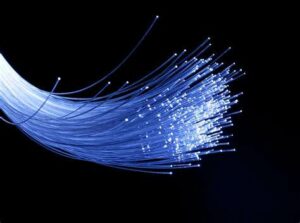When advances in technology occur and they are not widely understood, often there are mistruths or myths that arise around them. Fiber Internet is no exception as it has burst on the scene offering unheard of speeds. As the deployment of fiber Internet increases and knowledge grows, the myths will be dispelled and fiber will take its place, like the telephone did over 100 years ago, as the technology for the next century.
We thought we’d start early in fiber’s lifecycle to debunk the most common myths about it and shed a little light on what is the single fastest means for delivering high-speed Internet.
Myth 1 — Fiber Internet Is Too New and Unproven
Fiber has been around for a long time. In the 1880’s Alexander Graham Bell first used light to deliver sound, but it wasn’t until the late 1970s that its commercial application first happened. By the late 1990s, it began to flourish and became widely used both for commercial and residential use by major network service providers.
began to flourish and became widely used both for commercial and residential use by major network service providers.
Myth 2 — Fiber Internet Is Costly and Out of The Reach for Most
While fiber Internet traditionally has been more costly, in recent times its prices have been becoming more competitive. The question isn’t necessarily cost, but what’s the value? When understanding the benefits and features of fiber Internet over other solutions, fiber Internet offers the best value for performance, reliability, and speed. For lower income families, prices have been reduced even more dramatically with government support.
Myth 3 — Fiber Optic Cables Are Easily Broken
It is true that fiber optic cable is made of thin glass fibers which would lead one to believe the fibers can easily be broken. The truth is, the glass fibers are buffer coated to prevent damage and with the flexibility of the cabling, fiber is quite durable, unless cut accidentally by digging.
Myth 4 — Fiber Internet Is Not For Residential Use
Because of the speed of fiber, many people think it has to be exclusive to commercial use. Today’s homes are increasingly filled with a range of smart devices, requiring faster upload and downloads without any significant limits on the number of devices running at the same time. From smartphones, gaming systems, and smart televisions to computers, tablets and even video doorbells, homeowners are demanding the speed only fiber Internet can deliver.
Myth 5 — Weather Disrupts Fiber Internet Easily
Put simply and directly, fiber optic cables are not vulnerable to harsh weather conditions. These cables can be placed in water, therefore heavy rains, snow, and wind do not impact fiber Internet’s signal strength. While storm damage may harm above-ground cables, the weather itself does not impact signals like what happens with cable Internet and satellite.
Myth 6 — Fiber Internet Is No Different Than Cable, 5G or Other Types of Broadband Connectivity
Fiber Internet is faster and more reliable than traditional cable and telephone technology such as coaxial cable, copper DSL, and satellite Internet. Cable providers’ coaxial-based networks cannot deliver the speeds of fiber. The old copper-based DSL telephone network was great for the early days of dial up, AOL and CompuServe, but it cannot compete with fiber’s capabilities today. Furthermore, satellite Internet, while great for hard-to-get-to-places, is costly and still doesn’t provide the performance fiber Internet can.
Myth 7 — Content Is Limited Over Fiber Internet
With fiber Internet, once service is activated one can sign up online for all the traditional streaming services such as Disney+, Hulu, YouTube, and others to get content and even traditional broadcast programming through these services. The same is true for gaming. And this is only getting better as more traditional content providers offer attractive bundles for streaming.
Myth 8 – Accessibility Is The Biggest Downside of Fiber
Let’s face it. The biggest and probably only downside to fiber Internet is availability. Because it is a newer technology, fiber Internet is not available to everyone, everywhere, and it may take time to roll it out. The good news is availability, even for existing homes, is growing rapidly due to demand. Beyond that, fiber provides better service than other options and comes with few to no downsides.
Final Thoughts
Fiber Internet is becoming increasingly more available to consumers so these myths will be dispelled as people experience fiber Internet for themselves. Fiber Internet is fast, reliable, and future proof as additional fiber can easily be added to keep up with increasing bandwidth demand. As new homes become “smart,” a stable Internet connection will become more important for everyday life. Fiber Internet provides the perfect solution to keep up with growing demand. Interested in including fiber Internet in your next development? Reach out to Fiber Fast Homes, we can help hello@fiberfasthomes.com.
